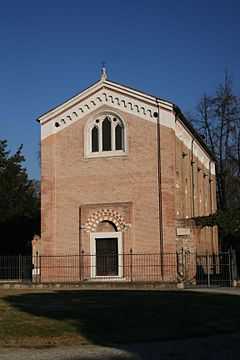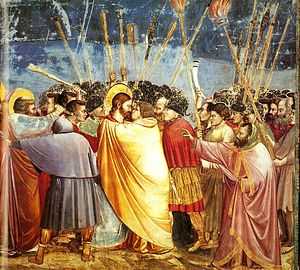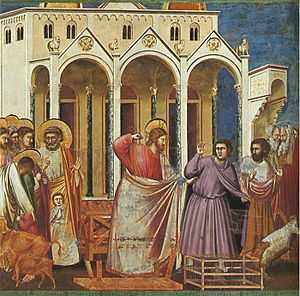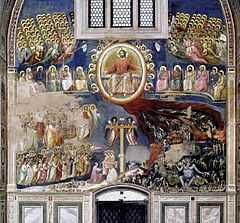Scrovegni Chapel


The Scrovegni Chapel (Italian: ''Cappella degli Scrovegni'', also known as the Arena Chapel), is a church in Padua, Veneto, Italy. It contains a fresco cycle by Giotto, completed about 1305, that is one of the most important masterpieces of Western art.
Name
The church was dedicated to Santa Maria della Carità at the Feast of the Annunciation, 1303, and consecrated in 1305. Giotto's fresco cycle focuses on the life of the Virgin Mary and celebrates her role in human salvation. A motet by Marchetto da Padova appears to have been composed for the dedication on 25 March 1305.[1] The chapel is also known as the Arena Chapel because it was built on land purchased by Enrico Scrovegni that abutted the site of a Roman arena. The space was where an open-air procession and sacred representation of the Annunciation to the Virgin had been played out for a generation before the chapel was built.
History
The chapel was commissioned by Enrico Scrovegni, whose family fortune was made through banking. At this time charging excess interest when loaning money was considered to be usury, a sin so grave that it resulted in exclusion from the Christian sacraments, and many early bankers were concerned lest their trade jeopardised their souls.[2] It has often been suggested that Enrico built the chapel in penitence for his father's sin of usury and to obtain absolution for his own. Enrico's father Reginaldo degli Scrovegni is one of the usurers encountered by Dante in the Seventh Circle of Hell. Recent studies have debated whether Enrico himself was involved in usurious practices and if the chapel was intended as restitution for his own sins. Some scholars tend to suggest that Giotto's frescoes in the chapel reflect these concerns with usury and penitence, although the issue is controversial and others see a more secular set of concerns.[3] Enrico's tomb is in the apse, and he is also portrayed in the Last Judgment presenting a model of the chapel to the Virgin.
The chapel was attached to a new palace built by Enrico Scrovegni and was ostensibly a family oratory, but it also served some public functions related to the Feast of the Annunciation.[4]
Giotto was an architect as well as an artist, and recent research has argued that he designed the chapel.[5]
Apart from Giotto's paintings, the chapel is unornamented and features a barrel vault roof. Giotto's Last Judgment covers the entire wall above the chapel's entrance and includes the aforementioned devotional portrait of Enrico. Opposite it, on the chancel arch above the altar, is an unusual scene of God in Heaven despatching an angel to Earth. Each wall is arranged in three tiers of narrative frescoes, each with four two-meter-square scenes. Facing the altar the narrative sequence begins at the top of the right hand wall with scenes from the life of the Virgin, including the annunciation to her mother, St. Anne, and the presentation at the temple. The series continues through the Nativity, the Passion of Jesus, the Resurrection, and the Pentecost. The panels are noted for their emotional intensity, sculptural figures, and naturalistic space. Beneath the main scenes at dado level, Giotto used a faux architectural scheme of painted marble decorations and small recesses containing figures of the Virtues and Vices painted in grisaille (monochrome). The Allegories of Justice and Injustice with their predella scenes oppose two understandings of government: the politics of peace leading to a Festival of Love and the politics of tyranny leading to wartime rape.[6]
One of the most gripping paintings in the chapel is Giotto's portrayal of the Kiss of Judas, the moment of betrayal that represents the first step on Jesus' road to the Crucifixion.[7]
Anthology of images
.jpg) | |
|
| |
|
| |
|
| |
|
|
The iconography of the fresco cycles are those of the Life of Christ and the Life of the Virgin. The Annunciation occupies a central position over the chancel arch.
- The Expulsion of Joachim
- Joachim amongst the shepherds
- An angel comes to Anna in prayer announcing the birth of Mary
- Joachim sacrifices a kid goat to the Lord
- Joachim's dream
- Joachim meets Anna at the Golden Gate
- Nativity of Mary and bathing the infant
- Presentation of Mary at the Temple
- The bringing of the branches
- Prayer for the blossoming of the branches
- The marriage of the Virgin
- The nuptial cortege

- The mission of the Annunciation to Mary
- The Annunciation
- Visitation
- The Nativity of Jesus
- The Adoration of the Magi
- The Presentation of Jesus at the Temple
- The Flight into Egypt
- The Massacre of the Innocents
- The Finding in the Temple (Jesus among the doctors)
- The Baptism of Jesus
- The Wedding at Cana
- The Resurrection of Lazarus
- Christ enters Jerusalem
- Casting out the money changers
- Judas's Betrayal

- The Last Supper
- The washing of the feet
- The Kiss of Judas
- Jesus before Caiaphas
- Flagellation of Christ
- The ascent to Calvary
- Crucifixion
- Lamentation of Christ
- The Resurrection of Jesus — "Noli me tangere"
- Ascension
- Pentecost
- The Last Judgment
- Allegories of the Vices and the Virtues
Notes
- ↑ Anne Robertson 'Remembering the Annunciation in Medieval Polyphony' Speculum70 (1995), 275-304
- ↑ Stokstad, Marilyn
- ↑ For arguments favouring a usury and penitence theme see Anne Derbes and Mark Sandona, The Usurer's Heart: Giotto, Enrico Scrovegni, and the Arena Chapel in Padua. Pennsylvania State University Press, 2008. For arguments against this idea, and highlighting secular concerns, see Laura Jacobus 'Giotto and the Arena Chapel: Art, Architecture and Experience' Brepols/Harvey Miller Publications, 2008
- ↑ The functions of the chapel are explored in Laura Jacobus, 'Giotto and the Arena Chapel...' esp. Chs. 2, 9 and 10. The connection of the Annunciation of the fresco cycles and the feast is also explored by Laura Jacobus, "Giotto's Annunciation in the Arena Chapel, Padua" The Art Bulletin 81.1 (March 1999), pp. 93-107.
- ↑ The argument that he designed the chapel is advanced in Laura Jacobus 'Giotto and the Arena Chapel...' Ch3 and 4. Gary Radke argues against this idea in 'Giotto and Architecture' in Anne Derbes and Mark Sandona 'The Cambridge Companion to Giotto' (Cambridge University Press, 2003), 76-102
- ↑ Péter Bokody, "Justice, Love and Rape: Giotto’s Allegories of Justice and Injustice in the Arena Chapel, Padua," In The Iconology of Law and Order, ed. Anna Kerchy and others (Szeged: JATE Press, 2012), 55-66. https://www.academia.edu/1850088/Justice_Love_and_Rape_Giottos_Allegories_of_Justice_and_Injustice_in_the_Arena_Chapel_Padua
- ↑ Stokstad, Marilyn
- ↑ "Giotto's Arena (Scrovegni) Chapel". Smarthistory at Khan Academy. Retrieved March 26, 2013.
Bibliography
- Bokody, Péter. "Justice, Love and Rape: Giotto’s Allegories of Justice and Injustice in the Arena Chapel, Padua." In The Iconology of Law and Order, ed. Anna Kerchy and others, 55-66. Szeged: JATE Press, 2012.
- Derbes, Anne, and Mark Sandona. The Usurer's Heart: Giotto, Enrico Scrovegni, and the Arena Chapel in Padua. Pennsylvania State University Press, 2008.
- Derbes, Anne, and Mark Sandona, eds. The Cambridge Companion to Giotto. Cambridge University Press, 2004.
- Frugoni, Chiara L'affare migliore di Enrico: Giotto e la cappella Scrovegni Einuadi, 2008
- Jacobus, Laura Giotto and the Arena Chapel: Art, Architecture and Experience Brepols/Harvey Miller Publications, 2008
- Ladis, Andrew Giotto's O Pennsylvania State University Press, 2008
- Giuliano Pisani, L’ispirazione filosofico-teologica nella sequenza Vizi-Virtù della Cappella degli Scrovegni, «Bollettino del Museo Civico di Padova», XCIII, 2004, Milano 2005, pp. 61–97.
- Giuliano Pisani, Terapia umana e divina nella Cappella degli Scrovegni, in «Il Governo delle cose», dir. Franco Cardini, Firenze, n. 51, anno VI, 2006, pp. 97–106.
- Giuliano Pisani, L’iconologia di Cristo Giudice nella Cappella degli Scrovegni di Giotto, in «Bollettino del Museo Civico di Padova», XCV, 2006, pp. 45–65.
- Giuliano Pisani, Le allegorie della sovrapporta laterale d’accesso alla Cappella degli Scrovegni di Giotto, in «Bollettino del Museo Civico di Padova», XCV, 2006, pp. 67–77.
- Giuliano Pisani, Il miracolo della Cappella degli Scrovegni di Giotto, in Modernitas – Festival della modernità (Milano 22-25 giugno 2006), Spirali, Milano 2006, pp. 329–57.
- Giuliano Pisani, Una nuova interpretazione del ciclo giottesco agli Scrovegni, in «Padova e il suo territorio», XXII, 125, 2007, pp. 4–8.
- Giuliano Pisani, I volti segreti di Giotto. Le rivelazioni della Cappella degli Scrovegni, Rizzoli, Milano 2008 (ISBN 9788817027229).
- Giuliano Pisani, Il programma della Cappella degli Scrovegni, in Giotto e il Trecento, catalogo a cura di A. Tomei, Skira, Milano 2009, I – I saggi, pp. 113–127.
- Stokstad, Marilyn; Art History, 2011, 4th ed., ISBN 0-205-79094-1
- Giuliano Pisani, La fonte agostiniana della figura allegorica femminile sopra la porta palaziale della Cappella degli Scrovegni, in «Bollettino del Museo Civico di Padova», XCIX, 2010 (2014), pp. 35-46.
External links
| Wikimedia Commons has media related to Cappella degli Scrovegni (Padua). |
- Official website
- Virtual Tour and Information
- Scrovegni Chapel Frescoes Analysis and Critical Reception
| ||||||
Coordinates: 45°24′42″N 11°52′46″E / 45.41167°N 11.87944°E